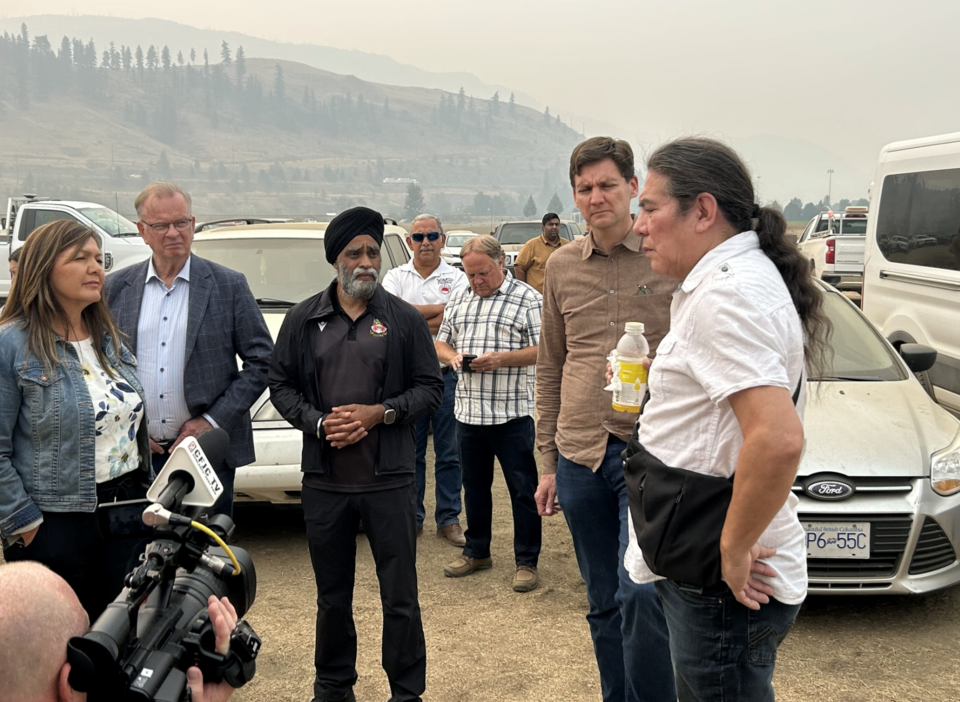This week the provincial government reported it had evacuated 27,000 people from their homes due to wildfires across B.C., largely on account of those in the Okanagan and Shuswap Lake region.
A disproportionate number of those evacuees are from First Nations reserves, a fact that aligns with historic trends of natural disasters in Canada, says risk analyst and disaster response expert Lily Yumagulova of the Canadian Climate Institute.
“The first important thing to keep in mind is the disproportionate impacts that First Nations communities are faced with,” Yumagulova told Glacier Media in an interview discussing the unique challenges Indigenous people are faced with during evacuations.
This week the First Nations Emergency Services Society reported as many as 3,598 Indigenous people living across 10 First Nations communities were under an evacuation order in B.C.; another 12 are under an evacuation alert. That means the reserve residents account for at least 13.3 per cent of all evacuees in the province.
Add to that the Westbank First Nation near West Kelowna, where Statistics Canada says only 948 residents live on reserve land out of a population of 10,660, and that number is likely much higher.
Across Canada, the trend is much the same: Indigenous people make up 4.9 per cent of Canada’s population, but those living on reserves alone accounted for 27 per cent of natural disaster evacuees between 1980 and 2020, according to Natural Resources Canada. And over the past two decades, the number of evacuees on reserves has more than doubled to nearly 65,000.
Evacuating on First Nations can be more difficult
Evacuating First Nations communities is not as simple as evacuating non-Indigenous communities, said Yumagulova. That's partly because of the colonial legacy of reserve formation.
“A lot of communities were placed on marginalized pieces of land, that are prone to risk, either flood risk, or obviously wildfires and so on and so forth,” Yumagulova said.
While that First Nations communities are 18 times more likely to be evacuated due to disasters compared to non-Indigenous communities, many reserves were created with just one road in and one road out, Yumagulova said.
“First Nations people were controlled whether they can leave the reserve, or not. And it was an easier way to control if there was just one road in and one road out,” she said.
“And it becomes a death trap... if you can't evacuate under the scenario.”
Yumagulova says reserves also face chronic underfunding for disaster mitigation and emergency response mechanisms.
“A lot of the fire departments are volunteer; they're understaffed, obviously, because, you know, it's very hard for somebody to have a job and then also be a volunteer firefighter. They don't have the adequate equipment, and the list goes on,” she said.
88 First Nation disaster recovery projects unreviewed or unfunded
In 2022 Canada’s Auditor General produced a report critical of Indigenous Services Canada for failing to fund and approve infrastructure projects that would minimize the impact on First Nations recovering from natural disasters.
Some of the projects were aimed at preventing or reducing the impact of emergencies. They included reducing the intensity and spread of wildfires by removing branches and trees, or building culverts and dikes to prevent seasonal floods.
“Many issues have not improved since we first identified them in our 2013 audit of emergency management on reserves,” the auditor wrote.
The report found that in B.C. there were 25 unreviewed and 63 eligible but unfunded “structural mitigation projects,” whereas just 12 had been completed and 17 were in progress.
Glacier Media has asked for a list of those 88 unreviewed or unfunded projects but has yet to receive a response from Indigenous Services Canada.
'Another form of forced displacement'
Questions around culture and self-determination can also complicate evacuations for Indigenous people, said Yumagulova.
For example, elders who have been through the residential school system may have a heightened anxiety about being relocated.
“So, for elders, this triggers residential school trauma, right; it's another form of forced displacement. And that's why there needs to be a distinction-based approach when it comes to evacuations in First Nations communities,” she said.
Earlier this month, the provincial government partnered with Tk'emlúps te Secwépemc First Nation to establish a permanent evacuee lodge for up to 300 people in Kamloops, B.C. It is being managed by the Ministry of Emergency Management and Climate Readiness “with cultural and traditional support provided by Tk'emlúps te Secwépemc, including a cultural activity space to support smudging and prayer.”
Premier David Eby visited the Ts̓ellétkwe Lodge with Tk'emlúps te Secwépemc Chief Rosanne Casimir this week after severe fires ripped through the Interior, displacing thousands of people.
Yumagulova said governments typically centre their disaster response centres around property rights, such as home and auto insurance considerations.
When First Nations lose their homes, “it takes years and years” before they are rebuilt because Indigenous people need to work through the federal government, said Yumagulova.
At the same time, reserve residents are often tied to their land more so than non-Indigenous people, making rebuilding more complex and difficult, Yumagulova added.
Fund emergency response and learn from First Nations, says expert
There have been some positive signs emergency response on reserves is getting better. Yumagulova said she was pleased to see how Indigenous communities responded to the “heat dome” of 2021 when extreme heat killed over 600 British Columbians. During that extreme heat, Indigenous elders did not suffer disproportionately because they had a better community care network, said Yumagulova.
“What was absolutely incredible is that in every single community, elders were immediately prioritized, either through family, kinship systems, or proactive communities; they were put in place to really protect the elders,” said Yumagulova.
It's one example where Yumagulova says broader society can learn from Indigenous people. But first, they need to be equipped with the proper resources to handle disasters.



